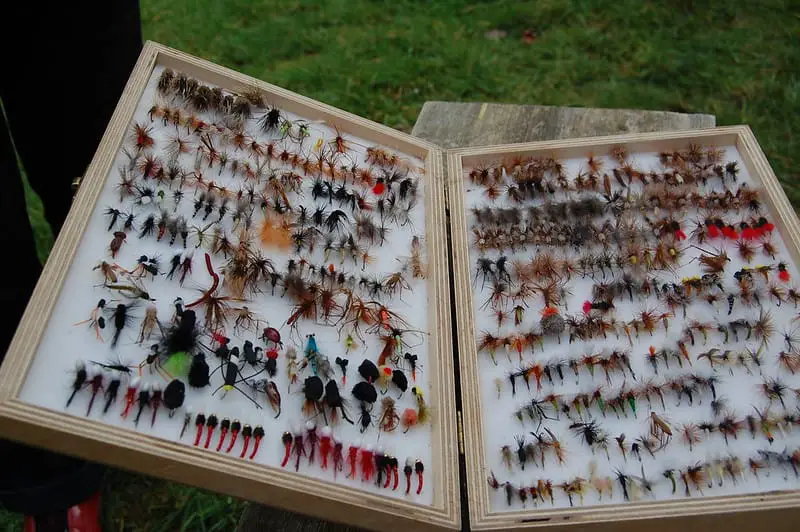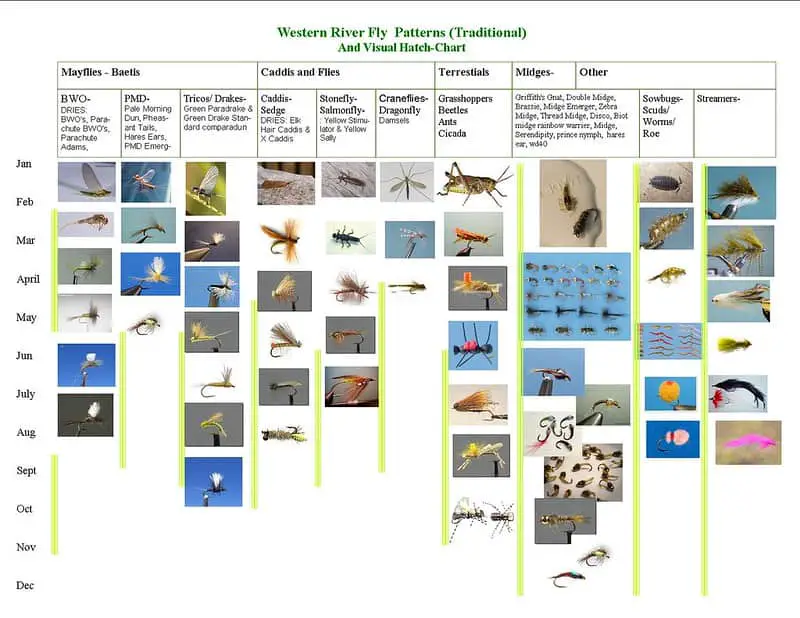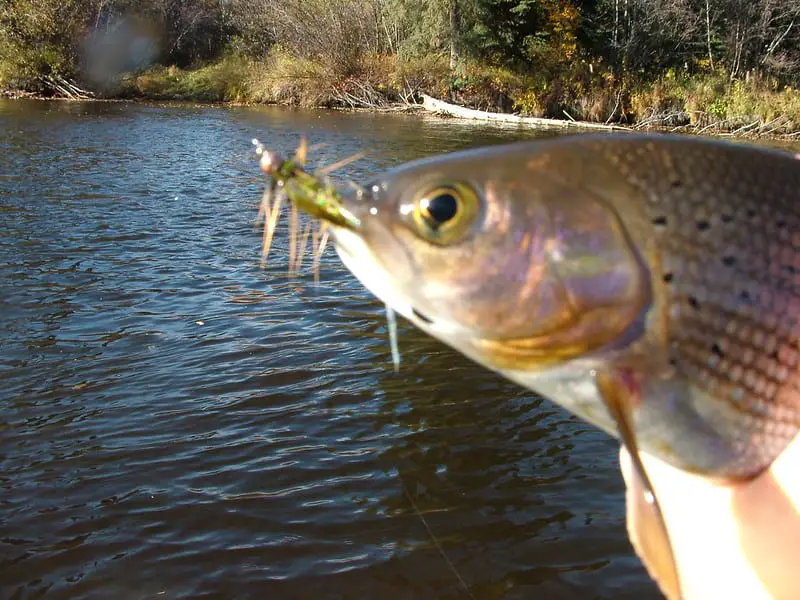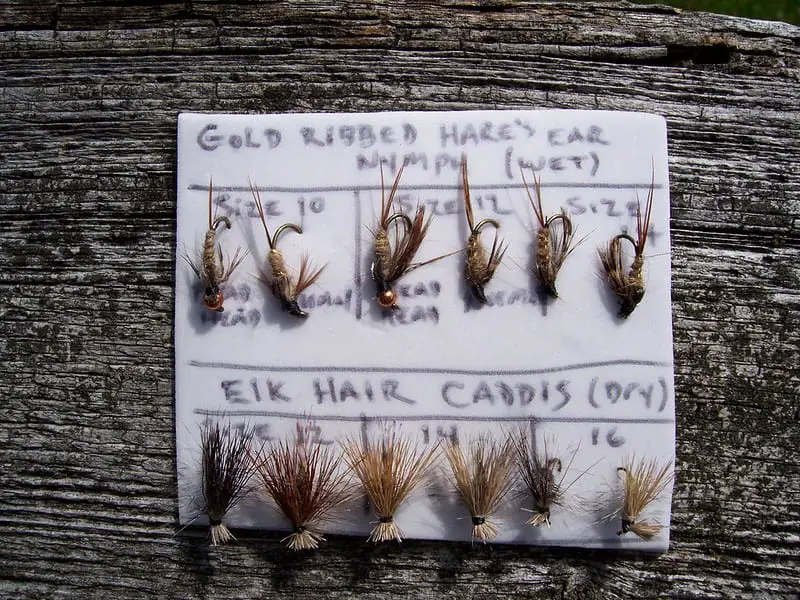Disclosure: Some posts contain affiliate links, which earn us a commission if you make a purchase through them. Positive Fishing © participates in various affiliate networks including the Amazon Services LLC Associates Program.
In fly fishing, it doesn’t matter how nice your gear is, how perfect the water is or how far you can cast. If you don’t have the proper fly choice, you’re going to struggle to catch the amount of fish you would like.
Fly presentation is vital, but using a fly that doesn’t fit the normal diet of the fish you’re targeting, you’ll struggle to land fish. Understanding the proper flies to use takes time and experience, but the extra effort to learn will lead to more fish.
In this article, I will cover:
- Different Types of Flies
- Things to Know When Deciding Which Fly To Use
- Location
- Moving Water
- Still Water
- Best Time of The Year For Which Fly To Use
- Size of Fly
Different Types of Flies

The hundreds of patterns available for anglers to choose from are intimidating. Whether you’re looking to fish on the surface or dive deep, it can take years of fishing experience to learn your best options and strategies.
Streamers
Streamers are a fan favorite for anglers. Streamers are representations of larger bait and prey for predatory fish. Streamer patterns can include anything from minnows to crayfish. Other representations include leeches, panfish, and even rodents. If you know the fish you’re targeting desire to eat larger prey, then you can likely find a streamer representation of it.
These flies are often weighted and fall quickly towards the bottom of the water column. If you’re using them, you should know whether or not the fish are feeding on or near the bottom. If they are, then you’re good to use them!
If you see the fish feeding on the surface, streamers would still work, but topwater flies would be more effective.
These streamer flies are tied on size 0 to 6 hooks. They can be used in any body of water and for any type of fish. At times, these flies are too big for some of the smaller fish. You’re likely going to land larger fish when you use streamers. This is obviously a great thing, but make sure the equipment you have is able to handle anything that’s a bit bigger. Use a 4-weight or heavier if you’re using a bit larger streamer. Casting will be easier and you’ll have more power to fight fish.
You can read more detailed information on fishing with streamers here!
Nymphs
Nymphs are representations of the nymph stage of an insect. This is the next stage after an insect hatches. At this point in an insect’s life, they’re focused on growing and gaining strength to mate. They often attach themselves to rocks or other surfaces on the bottom of lakes and rivers to eat and grow. At times, they’ll dislodge and float through the water. This is when fish often feed on them! As they get closer to the adult stage, nymphs will start making their way towards the surface to fully hatch.
Fish absolutely love nymphs. Nymphs are a pattern that will work year-round. It doesn’t matter if you’re fishing in the dead of winter or in the heat of the summer. You can always count on nymphs working. Nymphs represent Mayflies, Caddisflies, and a variety of other insects.
You can read more detailed information on fishing with Nymphs here!
Dry Flies
Dry flies are adult fly representations. Insects that hatch out of the water will finalize their growth on the surface of the water. Wings will dry and they’ll begin flying and attempt to mate.
The lifespan of an adult insect is often only a couple of weeks. Dry flies are most successful when hatches occur. This is often when the sun rises and when the sun sets. Dry fly fishing is a blast.
You can read more detailed information on fishing with dry flies here!
Things to Understand When Choosing The Right Fly To Use

When it comes time for you to choose what fly is going to work best, there are a few things to consider. Choosing a fly at random and throwing it in the water is rarely the best recipe for success. You’ll need to make sure you’ve studied and understood the hatch patterns and fish diets.
Location
Different areas of the world are going to have different insects. If you’re visiting an area of the world that’s popular in the world of fly fishing, there is going to be a hatch chart for you to access. Fly shops and local fishing websites will provide these for you. Hatch charts show the insects that hatch in the area and the months that they’re going to be the most prevalent.
Hatch charts are an extremely useful resource. Make sure you are using the right hatch chart for the river and area that you are fishing, there are variations for different locations.
Tip: Whilst hatch charts are extremely useful, they need to be updated regularly. A chart from last year may not be exactly accurate for following years.
If you’re unable to locate a hatch chart, you still have hope. Finding the most accurate information is going to require a trip to the water. Once you’re at your desired fishing location, do your best to turn over rocks or logs in the water. You’ll find insects attached to the bottom of these rocks. The insects attached are likely what the fish are eating! Do your best to find a similar pattern in your fly box and tie it on your line.
Moving Water

Fly choice is a bit less important when you’re fishing moving water than it is when you’re fishing still water. When the water is moving, fish have less time to see your fly and properly react. Often, they’re reacting out of instinct and you’re able to trick more fish if your pattern isn’t exactly perfect.
You can also assume that streamers are almost always going to work. Find pools and deeper portions of the deeper water and throw classic patterns like Clouser Minnows and Woolly Buggers. If you provide enough movement, fish will strike these patterns regardless of whether or not they’re truly accurate representations of their normal food. If streamers are not working, use the method of looking at the bottom of rocks or logs to determine whether or not the flies you’ve chosen are similar to what the fish are eating.
If the fish are feeding on the surface, you’ll find that Parachute Adams and Elk Hair Caddis flies are great searching flies. If you do your best to match the size of the fly you see hatching, you have a chance.
Again, consult with a local fly shop to determine what’s hatching. They’ll be able to provide you with the most up-to-date information.
Still Water
Fly fishing still water can be very difficult if you don’t know what flies are going to work. You’re likely going to have to throw search patterns like Woolly Buggers, Clouser Minnows, and Bunny Leeches to see what may or may not work. As long as you’re spending time in areas where fish are most likely to sit, then you have a chance at landing some of them.
Depending on the fish you’re targeting, you may be able to see what they’re eating. If you see minnows or crayfish or leeches swimming in the shallow water, it’ll give you a better idea of what to throw.
If the fish are feeding on the surface, stick with the Parachute Adams and Elk Hair Caddis to help you search until you gain a better idea of what is hatching. Locate a hatch chart before you head to the water.
Best Time of Year For Choosing Which Fly
The time of year can also heavily influence your choice of fly. For a general rule of thumb:
- Blue Winged Olives or Mayflies are going to hatch more in the beginning of the fishing season and work well throughout the winter.
- Terrestrial patterns are going to provide the most fish late in the summer.
- Streamers will also work well late in the spring, summer and fall.
- Caddisflies come once runoff season concludes and Stonefly patterns are better in the warmer months.
Hatch charts will give you more specific detail about the rivers and lakes you’re interested in fishing, but there are a few universal truths when it comes to life cycles and patterns of flies.
As long as you know the basics of what hatches when, you have a chance to land fish. When in doubt, stick with Mayfly and streamer patterns. They’ll help you search!
Size of Fly

The final question that many anglers ask is what size fly should I use?
Very little food is going to be too small for fish. However, you will run into the problem of a fly being too large for fish. If you’re using a size 0 fly and targeting 8-inch brook trout, you may not get too many takers.
It’s best to start by using a fly that’s too small and have the freedom to move larger later, than start with a fly that’s too big and have to move smaller. By the time you have to move smaller, you may have blown the holes and spooked fish. In general, streamers size 2-8 will entice most fish.
Nymphs size 10-18 are going to be prime sizes for fish. Dry fly sizes 12-20 are manageable for almost all fish. Unless you’re absolutely confident that the fish you’re targeting want extremely small or extremely large flies, then stick to the standard sizes.
The most common times to use extremely small flies are when the water is gin clear. Fish may be spooking at almost any movement, so you’re going to have to minimize the size of your fly to make sure the fish hangs around where you cast. Choosing extra-large flies is likely only going to happen if you’re going after trophy fish!
Final Thoughts
Choosing the right fly to use when fly fishing can be a little confusing. However, once you start gaining experience and knowledge this becomes second nature.
Always experiment and don’t be frightened to change things around, going against the norm can still result in a few surprises!
I hope you enjoyed this article and gave you some tips and learnings on choosing which flies to use and when. You can read more on my article on the best flies for trout here!
- Wading Belt Essentials: Ensuring Safer Fishing - January 9, 2024
- Fishing For Catfish (Top Tips, Bait, & Gear To Catch The Big 3) - October 20, 2022
- Fishing Line Strength Vs. Diameter Chart: Why Is It Important? - October 12, 2022

